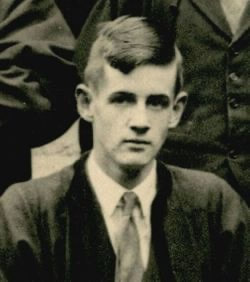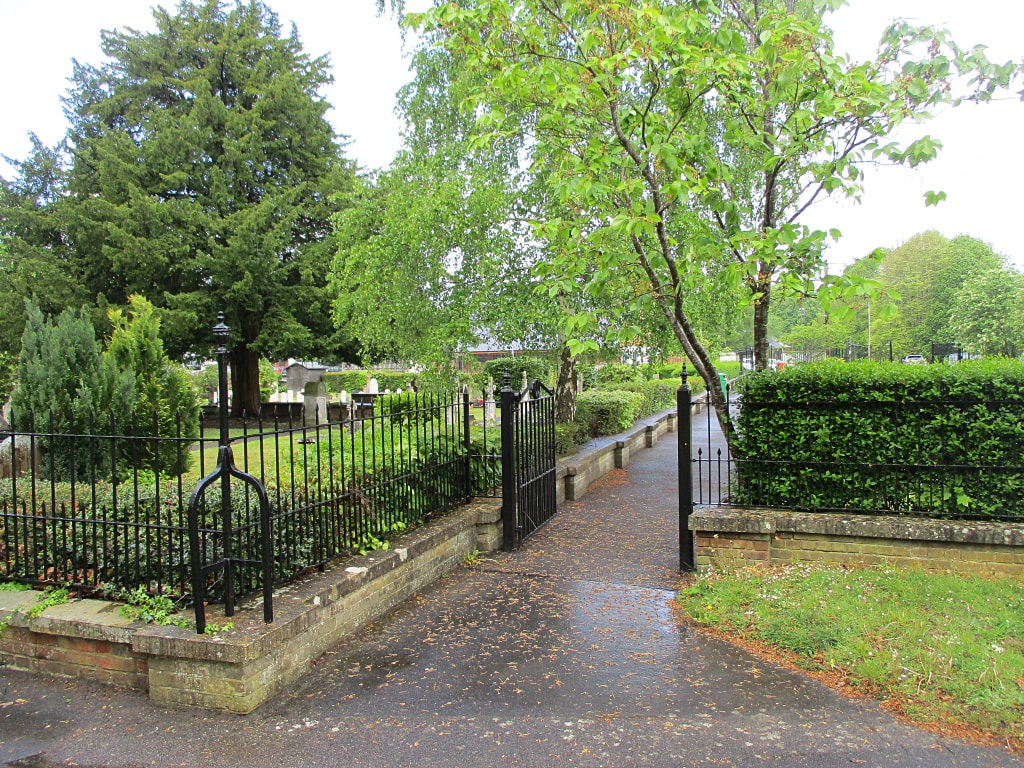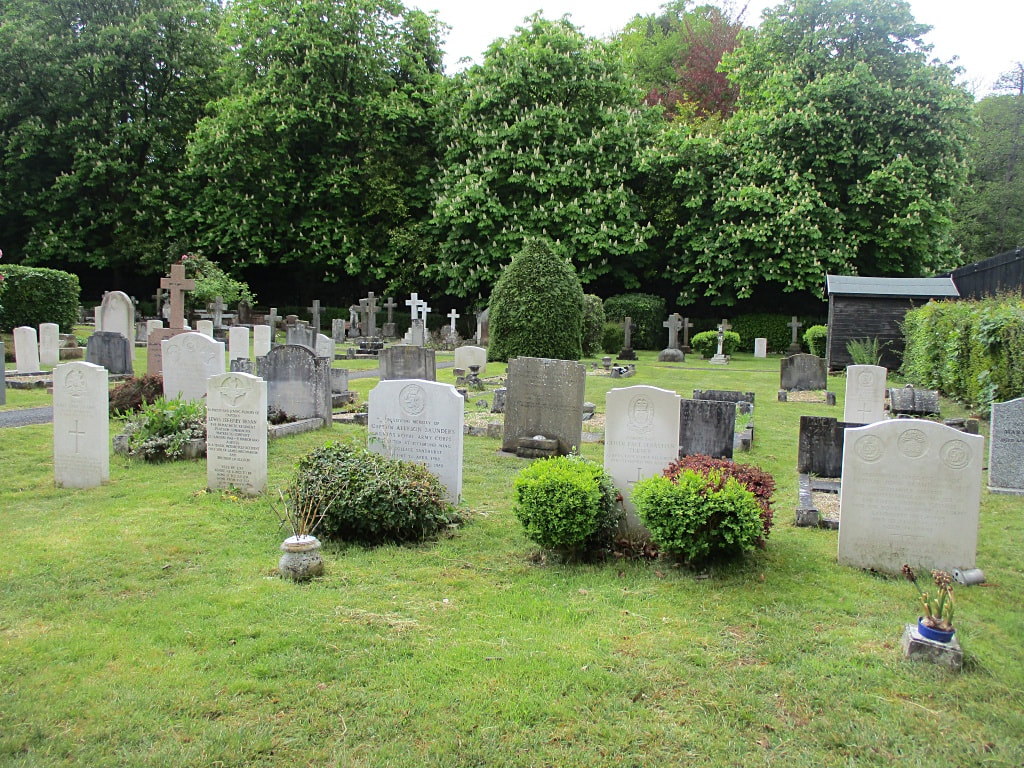SANDHURST ROYAL MILITARY ACADEMY CEMETERY
Berkshire
England
GPS Coordinates: Latitude: 51.34349, Longitude: -0.76743
Location Information
Sandhurst Royal Military Academy is located on Egerton Road near Camberley.
Visiting Information
This cemetery is within the grounds of the Royal Military Academy Sandhurst and permission to access the cemetery will need to be obtained from the Academy, prior to making a visit. The phone number for the Academy is 01276-63344.
Historical Information
Total Commission Burials: 34.
World War One Casualties: United Kingdom 9.
World War Two Casualties: United Kingdom 12.
Sandhurst Royal Military Academy is located on Egerton Road near Camberley.
Visiting Information
This cemetery is within the grounds of the Royal Military Academy Sandhurst and permission to access the cemetery will need to be obtained from the Academy, prior to making a visit. The phone number for the Academy is 01276-63344.
Historical Information
Total Commission Burials: 34.
World War One Casualties: United Kingdom 9.
World War Two Casualties: United Kingdom 12.
Images in the gallery below used with the permission of the Commonwealth War Graves Commission
World War One Roll of Honour

39859 Private
George Thomas Atkins
Royal Army Medical Corps
4th December 1918, aged 36.
556.
The information below supplied by 'The Ellesmerian Club', the alumni organisation for Ellesmere College where George was a pupil.
George Thomas Atkins
Royal Army Medical Corps
4th December 1918, aged 36.
556.
The information below supplied by 'The Ellesmerian Club', the alumni organisation for Ellesmere College where George was a pupil.
George Thomas Atkins was just eleven years old when he was admitted to the ‘Alfred’ dormitory at Ellesmere College on 15th September 1893. Thirty new boys arrived at the college that day and another young entrant who shared the same dormitory as George was Harold William Lovelock who also died on active service during the war.
Few records exist but it is known that George was awarded the Form Lower III Divinity Prize at Speech Day & Prizegiving 1894 and that he played cricket and rugby for his dormitory. At Sports Day 1894 he was unplaced in the ‘Throwing the Cricket Ball’ competition but The Ellesmerian recorded that he “threw well”. He took 1stplace in the Junior Hurdles finishing in 22.2 seconds. In December 1894, in his fourth term he abruptly left the college. It is not known where he continued his education.
George was the eldest of four children of George Marshall, a schoolmaster, and his wife Elizabeth. At the time of the 1881 Census the family lived in Gloucester, ten years later they were resident at Long Street, Tetbury but by the time that George Junior arrived in north Shropshire in 1893 they had moved further south to Tufnell Park Road, London. The 1901 Census recorded that George Junior was 21 years old, single and employed as a tutor in Hornsey, Middlesex.
The next year George’s status changed as, on 2nd August 1902, he married Alice Emma Cuming at St. Mary’s Parish Church, Wimbledon. On the wedding certificate he stated he was a schoolmaster and resident in Wellington, Shropshire. They went on to have three children Herbert (b.1903), Mary (b.1905) and Norman (b.1910). What is particularly interesting is that the 1911 Census reveals that Mary was born in Hamburg and Norman in Norway indicating that the family may well have travelled extensively. That Census recorded that both George and Alice were secondary school teachers and the family lived in Islington, London.
When war was declared, George would have been 34 years old. He wasted no time at all in volunteering and enlisted on 8th October 1914 as Private Atkins, Service No: 39859 in the Royal Army Medical Corps. Exactly where or when he saw active service is not known but the few records that have survived indicate he embarked overseas with the British Expeditionary Force in France on 25th July 1915.
George served in the R.A.M.C. throughout the war and had almost certainly been admitted to the Cambridge Hospital, Aldershot by the time the Armistice was signed on 11th November 1918. He was receiving treatment for septic arthritis, incurred whilst serving in the horrific field conditions of the Western Front. He died on 4thDecember 1918 and was buried in Sandhurst Royal Military Academy Cemetery. Interestingly, his headstone indicates his age as being 33 years – another case of the wrong date of birth being given at the time of enlistment? George may well have thought that he would be turned down if he declared his true age or just a clerical error?
For his wartime service, George was awarded the Victory Medal, the British War Medal and the 1914-1915 Star.
Few records exist but it is known that George was awarded the Form Lower III Divinity Prize at Speech Day & Prizegiving 1894 and that he played cricket and rugby for his dormitory. At Sports Day 1894 he was unplaced in the ‘Throwing the Cricket Ball’ competition but The Ellesmerian recorded that he “threw well”. He took 1stplace in the Junior Hurdles finishing in 22.2 seconds. In December 1894, in his fourth term he abruptly left the college. It is not known where he continued his education.
George was the eldest of four children of George Marshall, a schoolmaster, and his wife Elizabeth. At the time of the 1881 Census the family lived in Gloucester, ten years later they were resident at Long Street, Tetbury but by the time that George Junior arrived in north Shropshire in 1893 they had moved further south to Tufnell Park Road, London. The 1901 Census recorded that George Junior was 21 years old, single and employed as a tutor in Hornsey, Middlesex.
The next year George’s status changed as, on 2nd August 1902, he married Alice Emma Cuming at St. Mary’s Parish Church, Wimbledon. On the wedding certificate he stated he was a schoolmaster and resident in Wellington, Shropshire. They went on to have three children Herbert (b.1903), Mary (b.1905) and Norman (b.1910). What is particularly interesting is that the 1911 Census reveals that Mary was born in Hamburg and Norman in Norway indicating that the family may well have travelled extensively. That Census recorded that both George and Alice were secondary school teachers and the family lived in Islington, London.
When war was declared, George would have been 34 years old. He wasted no time at all in volunteering and enlisted on 8th October 1914 as Private Atkins, Service No: 39859 in the Royal Army Medical Corps. Exactly where or when he saw active service is not known but the few records that have survived indicate he embarked overseas with the British Expeditionary Force in France on 25th July 1915.
George served in the R.A.M.C. throughout the war and had almost certainly been admitted to the Cambridge Hospital, Aldershot by the time the Armistice was signed on 11th November 1918. He was receiving treatment for septic arthritis, incurred whilst serving in the horrific field conditions of the Western Front. He died on 4thDecember 1918 and was buried in Sandhurst Royal Military Academy Cemetery. Interestingly, his headstone indicates his age as being 33 years – another case of the wrong date of birth being given at the time of enlistment? George may well have thought that he would be turned down if he declared his true age or just a clerical error?
For his wartime service, George was awarded the Victory Medal, the British War Medal and the 1914-1915 Star.

Second Lieutenant
Alexander Cecil Henry Toogood
1st Bn. Lincolnshire Regiment
20th June 1921.
535.
Alexander Cecil Henry Toogood
1st Bn. Lincolnshire Regiment
20th June 1921.
535.
World War One Roll of Honour

6108057 Officer Cadet
Brian Martin Eames Gimson
The Queen's Royal Regiment (West Surrey)
8th December 1943, aged 19.
451.
Son of Martin and Mary Louisa Gimson, of Cosby, Leicestershire. Scholar of Winchester College and of New College, Oxford.
Brian Martin Eames Gimson
The Queen's Royal Regiment (West Surrey)
8th December 1943, aged 19.
451.
Son of Martin and Mary Louisa Gimson, of Cosby, Leicestershire. Scholar of Winchester College and of New College, Oxford.







